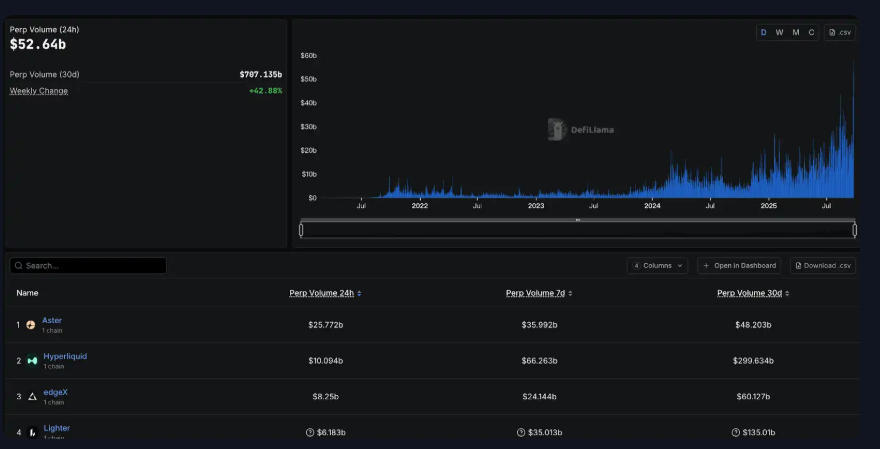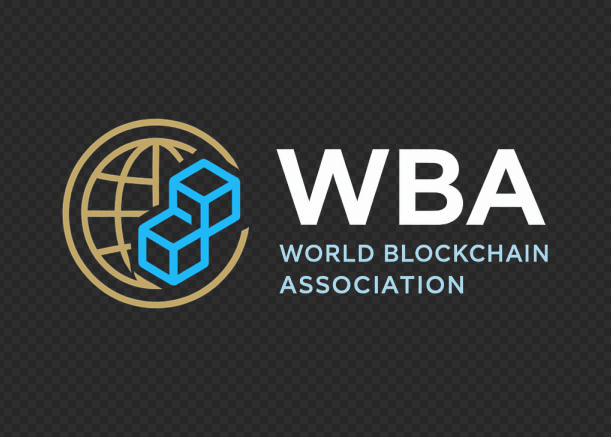
Date: September 27, 2025
The decentralized derivatives market is experiencing a defining moment. The rise of new perpetual decentralized exchanges (PerpDEXs) has ignited a competitive reshuffle, forcing even the most technologically advanced players, such as Hyperliquid, to rethink their positioning. In this in-depth analysis, the World Blockchain Association (WBA) examines the state of the global PerpDEX market, Hyperliquid’s evolving ecosystem, and the innovations shaping the next phase of decentralized finance (DeFi) and Web3 infrastructure.
Global Perpetual DEX Market: Explosive Growth and Structural Shifts
The decentralized perpetual exchange segment has emerged as one of the most dynamic pillars of the cryptocurrency derivatives landscape. As of September 2025, daily trading volumes across PerpDEX platforms have exceeded $52 billion, marking a 530% increase since the start of the year. Cumulative monthly volumes are now approaching $13 trillion, a historic milestone reflecting not only technological innovation but also users’ growing preference for decentralized alternatives to centralized trading platforms.
This rapid acceleration coincides with mounting regulatory scrutiny of centralized exchanges, such as those offering leveraged Bitcoin and Ethereum products. By contrast, decentralized platforms, powered by transparent smart contracts and community governance models (DAO structures), are gaining both liquidity and legitimacy. In fact, PerpDEXs now account for 26% of the global crypto derivatives market share, compared to single-digit percentages just a year ago.
The competitive landscape is also becoming increasingly differentiated:
- Order Book Models (Hyperliquid, dYdX) dominate professional trading with deep liquidity and precise price discovery.
- AMM Models (GMX, Gains Network) attract retail users with simplified interfaces and instant execution.
- Hybrid Models (Jupiter Perps) attempt to merge the best of both worlds through dynamic liquidity solutions.
Against this backdrop, Hyperliquid has been a frontrunner, processing over $2.76 trillion in cumulative transactions with its cutting-edge central limit order book (CLOB) architecture. However, new entrants are rapidly closing the gap.
The Meteoric Rise of Aster DEX
Aster, born from the merger of APX Finance and Astherus and supported by YZi Labs and prominent backers including CZ, has quickly disrupted the market. On its token launch day, Aster surged 1,650%, registered $371 million in trading volume, and onboarded 330,000 new wallets.
Its innovations include:
- Leverage up to 1001x, appealing to high-risk traders.
- Hidden order functionality, akin to dark pools in traditional finance, designed to mitigate MEV risks.
- Yield-bearing collateral integration, allowing users to post interest-generating assets (such as asBNB) while simultaneously earning 5–7% annualized returns.
Within weeks, Aster’s total value locked (TVL) skyrocketed from $370 million to $1.73 billion—a 328% increase—driven mainly by BNB Chain liquidity. Daily volumes surpassed $20 billion, momentarily overtaking Hyperliquid in global market share.
This surge has fragmented trader preferences: while professional participants still prefer Hyperliquid for its unmatched execution speed and liquidity depth, Aster has attracted a wave of newcomers and multi-chain users with its CEX-like experience and simplified onboarding.
Hyperliquid: Innovation Leader Under Pressure
Hyperliquid remains one of the most technically advanced PerpDEX platforms in the world. Its proprietary HyperCore engine achieves:
- 200,000 order executions per second
- 0.2-second settlement latency
- $2.765 trillion cumulative perpetual trading volume
- $133.5 billion open interest
These metrics rival and even surpass many centralized exchanges, reinforcing Hyperliquid’s status as a foundational infrastructure in the DeFi ecosystem.
Yet, market share erosion is undeniable. Hyperliquid’s dominance has dropped from 71% in May and 80% in August to just 38% today, as emerging competitors like Aster capitalize on multi-chain strategies and retail-friendly incentives. At times, Aster has even overtaken Hyperliquid in both daily trading volume and protocol fee revenue.
Still, Hyperliquid’s competitive advantages remain significant:
- Deepest liquidity pools: Spreads on Bitcoin and Ethereum pairs remain as tight as 0.1–0.2 basis points.
- Robust technical certainty: One-block confirmations guarantee unmatched reliability.
- Comprehensive ecosystem: Over 100 projects have integrated, building a multi-layered financial infrastructure.
- Deflationary tokenomics: 99% of protocol revenues are directed to HYPE token buybacks and burns, with annualized income exceeding $20 billion.
Hyperliquid’s real strength lies not just in technology, but in the ecosystem effect it has fostered across DeFi protocols, liquidity staking platforms, and tokenization initiatives.
Inside the Hyperliquid Ecosystem: Key Protocols
- Kinetiq – The Liquidity Staking Backbone
With $1.75 billion TVL (78% of Hyperliquid’s DeFi assets), Kinetiq optimizes validator delegation through its AI-powered StakeHub algorithm, boosting yields up to 10–12% via a blend of PoS rewards, MEV capture, and DeFi integrations. - Based – Mobile Super-App
Based has emerged as the leading revenue-generating app on Hyperliquid, driving over $16.7 billion in cumulative trading volume. Its dual-token model ($PUP for XP boosts, $BASED for governance) incentivizes long-term loyalty while enabling Visa-linked real-world spending. - Pendle – Yield Tokenization Giant
By splitting yield-bearing assets like kHYPE into principal (PT) and yield (YT) components, Pendle has unlocked sophisticated investment strategies, pushing its TVL to $12.3 billion on HyperEVM. - HyperLend – Lending Infrastructure
Acting as the “credit bank” of the ecosystem, HyperLend supports $524 million TVL with innovative features like HyperLoop one-click leveraged lending, enhancing capital efficiency while maintaining strict risk isolation. - Hyperbeat – DeFi Super-App
Backed by institutional investors (Electric Capital, Coinbase Ventures), Hyperbeat integrates staking, lending, and automated yield optimization, with TVL nearing $387 million. - USDH – Native Stablecoin
Expected to launch in late 2025, USDH will be backed by U.S. Treasuries through Stripe Bridge and BlackRock partnerships. As a native stablecoin, it will reinforce ecosystem autonomy, capital efficiency, and competitiveness against established stablecoins like USDC.
Market Outlook: Can Hyperliquid Retain Its Edge?
Hyperliquid’s challenge lies in balancing cutting-edge technology with broader accessibility. While professional traders value its liquidity depth and execution reliability, emerging competitors are targeting retail adoption through Web3-friendly user experiences and aggressive multi-chain incentives.
Two upcoming initiatives could prove decisive:
- HIP-3 (Permissionless Perpetual Markets): This upgrade will enable anyone to launch custom perpetual contracts, from RWA derivatives to AI compute futures, potentially unlocking vast new market segments.
- USDH Stablecoin: Expected to manage $5.5 billion in assets, with 95% of revenues directed toward HYPE buybacks, USDH could strengthen the token’s long-term value capture and establish Hyperliquid as a fully sovereign DeFi economy.
The World Blockchain Association notes that Hyperliquid’s true moat may no longer be raw technology, but its interconnected ecosystem of staking, lending, yield tokenization, and stablecoin infrastructure. This integrated model mirrors traditional financial systems but within a decentralized, trustless framework.
Conclusion
The PerpDEX sector has entered a transformative stage, where speed, liquidity, and leverage are no longer sufficient to guarantee leadership. Hyperliquid faces intense competition from newcomers like Aster, but it retains significant advantages in technical infrastructure, liquidity depth, and ecosystem maturity.
According to the World Blockchain Association, the future of decentralized perpetual trading will be shaped by three forces:
- Ecosystem-driven resilience – Platforms that integrate multiple DeFi layers (staking, lending, tokenization, stablecoins) will secure sustainable advantages.
- Regulatory adaptability – With increasing oversight of centralized exchanges, decentralized models that balance compliance and innovation will thrive.
- Token value alignment – Deflationary mechanisms and native stablecoins will be crucial in reinforcing trust and capturing long-term value.
For investors, opportunities range from stable yields in liquidity staking to high-risk leverage products, depending on risk appetite. For the industry, the question is not whether PerpDEXs will dominate, but which ecosystems will emerge as the long-term winners of this reshuffle.
About the World Blockchain Association
The World Blockchain Association (WBA) is a global organization dedicated to advancing knowledge, policy dialogue, and innovation in blockchain and digital finance. As a leader in the blockchain and cryptocurrency space, the WBA provides stakeholders with trusted insights at the intersection of technology, regulation, and global economic trends through research, reporting, and thought leadership.







